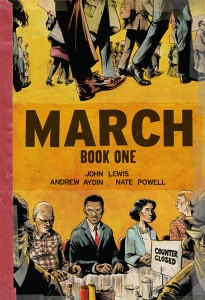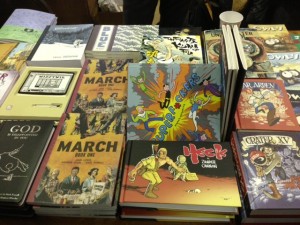 As a college student in 1958, John Lewis read a comic-book account of the Montgomery Bus Boycott and the activism of Dr. Martin Luther King, Jr. By that point, Lewis had come to question the Jim Crow measures that limited his and others’ access to a quality education, public facilities, and employment opportunities. In fact, Lewis had met with Dr. King’s attorney to discuss a possible lawsuit to attend an all-white state university in his home state of Alabama but decided not to pursue the matter out of fear from his family’s safety. Nonetheless, the comic-book account inspired Lewis to become a lifetime activist for the cause of civil rights and social justice through nonviolence.
As a college student in 1958, John Lewis read a comic-book account of the Montgomery Bus Boycott and the activism of Dr. Martin Luther King, Jr. By that point, Lewis had come to question the Jim Crow measures that limited his and others’ access to a quality education, public facilities, and employment opportunities. In fact, Lewis had met with Dr. King’s attorney to discuss a possible lawsuit to attend an all-white state university in his home state of Alabama but decided not to pursue the matter out of fear from his family’s safety. Nonetheless, the comic-book account inspired Lewis to become a lifetime activist for the cause of civil rights and social justice through nonviolence.
Today, Lewis is a member of Congress representing the Fifth District of Georgia, where he continues to advocate for economic justice and human rights. March Book One (Top Shelf Productions, 2013) is the first in a series of graphic novels based on Lewis’s life. It begins with the inauguration, on January 20, 2009, of the first black President of the United States. Before the ceremony, Lewis receives a visit from a family of constituents who have traveled from Atlanta to Washington, D.C. to view this momentous event. Lewis tells his story to the family’s son, beginning with his childhood on a farm near Troy, Alabama and ending with his leading a successful march in Nashville, Tennessee to desegregate lunch counters in 1958.
Like the comic book that he read, Lewis’s story is inspirational, showing readers that every person can make a difference. Early in life, Lewis decided that he wanted to be a minister – a delightful section of March Book One shows him preaching to the chickens on his family’s farm and experiencing emotional distress when a member of his “flock” ended up on the dinner table. When he journeyed North with an uncle, the youngster first realized that his life under Jim Crow segregation wasn’t the reality everywhere, and he didn’t have to accept things as they existed in his hometown and region. His political growth was gradual, though, and he had to be persistent and prepared to accept disappointment and failure on the road to the victories that he and his fellow activists attained.
March Book One honestly depicts the frank language and brutal realities of the time, though the black-and-white illustrations of this graphic novel are restrained enough to make it appropriate for middle grade readers. The format makes the title an excellent choice for a wide range of readers to explore the civil rights movement, nonviolent activism, and the remarkable life of a great American leader.
